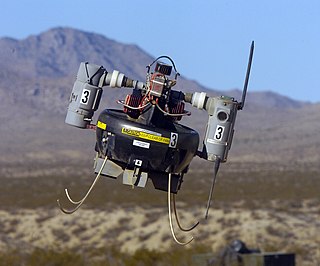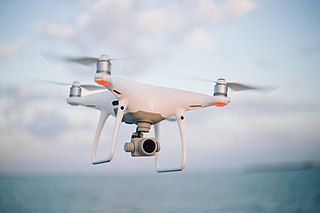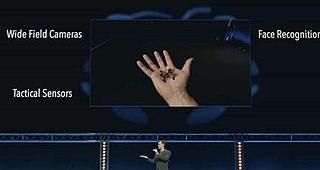Related Research Articles

An unmanned aerial vehicle (UAV), commonly known as a drone, is an aircraft without any human pilot, crew, or passengers on board. UAVs were originally developed through the twentieth century for military missions too "dull, dirty or dangerous" for humans, and by the twenty-first, they had become essential assets to most militaries. As control technologies improved and costs fell, their use expanded to many non-military applications. These include aerial photography, area coverage, precision agriculture, forest fire monitoring, river monitoring, environmental monitoring, policing and surveillance, infrastructure inspections, smuggling, product deliveries, entertainment, and drone racing.

A micro air vehicle (MAV), or micro aerial vehicle, is a class of man-portable miniature UAVs whose size enables them to be used in low-altitude, close-in support operations. Modern MAVs can be as small as 5 centimeters - compare Nano Air Vehicle. Development is driven by commercial, research, government, and military organizations; with insect-sized aircraft reportedly expected in the future. The small craft allow remote observation of hazardous environments or of areas inaccessible to ground vehicles. Hobbyists have designed MAVs for applications such as aerial robotics contests and aerial photography. MAVs can offer autonomous modes of flight.

Swarm robotics is an approach to the coordination of multiple robots as a system which consist of large numbers of mostly simple physical robots. In a robot swarm, the collective behavior of the robots results from local interactions between the robots and between the robots and the environment in which they act. It is supposed that a desired collective behavior emerges from the interactions between the robots and interactions of robots with the environment. This idea emerged on the field of artificial swarm intelligence, as well as the studies of insects, ants and other fields in nature, where swarm behaviour occurs.

A radio-controlled aircraft is a small flying machine that is radio controlled by an operator on the ground using a hand-held radio transmitter. The transmitter continuously communicates with a receiver within the craft that sends signals to servomechanisms (servos) which move the control surfaces based on the position of joysticks on the transmitter. The control surfaces, in turn, directly affect the orientation of the plane.

A radio-controlled helicopter is model aircraft which is distinct from a RC airplane because of the differences in construction, aerodynamics, and flight training. Several basic designs of RC helicopters exist, of which some are more maneuverable than others. The more maneuverable designs are often harder to fly, but benefit from greater aerobatic capabilities.

A quadcopter, also called quadrocopter, or quadrotor is a type of helicopter or multicopter that has four rotors.

Vehicular automation involves the use of mechatronics, artificial intelligence, and multi-agent systems to assist the operator of a vehicle such as a car, lorry, aircraft, or watercraft. A vehicle using automation for tasks such as navigation to ease but not replace human control, qualify as semi-autonomous, whereas a fully self-operated vehicle is termed autonomous.

Cholo is a video game released in 1986 for the BBC Micro. It was ported to the ZX Spectrum, Amstrad CPC, and Commodore 64. Cholo uses wireframe 3D visuals and has nonlinear gameplay.

The Picoo Z(also sold under the brand name of Air Hogs Havoc Heli in North America) is a miniature remote-controlled 2-channel helicopter manufactured by Hong Kong-based Silverlit Toys. In the United States it is distributed by Spin Master.

Daniela L. Rus is a roboticist and computer scientist, Director of the MIT Computer Science and Artificial Intelligence Laboratory (CSAIL), and the Andrew and Erna Viterbi Professor in the Department of Electrical Engineering and Computer Science (EECS) at the Massachusetts Institute of Technology. She is the author of the books Computing the Future and The Heart and the Chip.
Construction 3D Printing (c3Dp) or 3D construction Printing (3DCP) refers to various technologies that use 3D printing as a core method to fabricate buildings or construction components. Alternative terms for this process include "additive construction." "3D Concrete" refers to concrete extrusion technologies whereas Autonomous Robotic Construction System (ARCS), large-scale additive manufacturing (LSAM), and freeform construction (FC) refer to other sub-groups.

RoboBee is a tiny robot capable of partially untethered flight, developed by a research robotics team at Harvard University. The culmination of twelve years of research, RoboBee solved two key technical challenges of micro-robotics. Engineers invented a process inspired by pop-up books that allowed them to build on a sub-millimeter scale precisely and efficiently. To achieve flight, they created artificial muscles capable of beating the wings 120 times per second.

Yuneec International, established in 1999 in Hong Kong, China, is wholly owned by ATL Global Holding AG of Switzerland. The company has a research and development center headquartered in Zurich, Switzerland, a global market and marketing headquarters in Kaltenkirchen, Germany, and an OEM factory in Kunshan, Jiangsu, China. Initially focused on manufacturing electric remote-controlled model airplanes, Yuneec introduced human-crewed aircraft to the U.S. market through GreenWing International. The company's Yuneec International E430 was the first electric human-crewed aircraft designed for commercial production. Since 2012, Yuneec has concentrated on developing and producing unmanned aerial vehicles (UAVs). By the end of 2016, the company had established a new R&D center, Advanced Technology Labs Ltd, near Zurich, Switzerland, and had begun its global expansion.

The DelFly is a fully controllable camera-equipped flapping wing Micro Air Vehicle or Ornithopter developed at the Micro Air Vehicle Lab of the Delft University of TechnologyArchived 2019-10-19 at the Wayback Machine in collaboration with Wageningen University.

Diwakar Vaish is an Indian-born robotics researcher and Head of Robotics and Research at A-SET Training and Research Institutes (2010–present). He is the developer of India's first completely indigenous 3D printed humanoid robot (Manav), India's first mind controlled robot, and the world's first production brain controlled wheelchair. Diwakar is the co-creator of the world's cheapest ventilator, with the All India Institute of Medical Sciences, Delhi.

The Wingtra WingtraOne is a tail-sitting vertical take-off and landing unmanned aerial vehicle developed in Switzerland by Wingtra AG. Powered by two electric motors, it is designed primarily for use in precision agriculture and surveying roles, or for light payload delivery to rural areas.

Slaughterbots is a 2017 arms-control advocacy video presenting a dramatized near-future scenario where swarms of inexpensive microdrones use artificial intelligence and facial recognition software to assassinate political opponents based on preprogrammed criteria. It was released by the Future of Life Institute and Stuart Russell, a professor of computer science at Berkeley. On YouTube, the video quickly went viral, garnering over two million views and was screened at the United Nations Convention on Certain Conventional Weapons meeting in Geneva the same month.
Davide Scaramuzza is an Italian professor of robotics at the University of Zurich, specialising on micro air vehicles.
Cynthia R. Sung is an American roboticist known for her research on foldable robots. She is Gabel Family Term Assistant Professor of Mechanical Engineering & Applied Mechanics, with a secondary appointment in the Department of Computer and Information Science, at the University of Pennsylvania.
References
- 1 2 3 Coldewey, Devin (31 October 2016). "Piccolissimo joins the ranks of ultra-tiny flying robots". TechCrunch. Retrieved 3 January 2017.
- ↑ "UPENN students 3D print Piccolissimo, world's smallest self-powered flying robot". 3ders.org. Retrieved 3 January 2017.
- ↑ "Découvrez Piccolissimo, le plus petit drone volant au monde !" (in French). La Chaîne Info. 4 November 2016. Retrieved 3 January 2017.
- ↑ "Pocket-sized possibilities: Meet the smallest self-powered controllable drone". Digital Trends. 2 November 2016. Retrieved 3 January 2017.
- 1 2 3 "Here's the World's Smallest Drone Spinning Itself Into the Air". Popular Mechanics. 3 November 2016. Retrieved 3 January 2017.
- ↑ Mott, Nathaniel. "UPenn 3D-Printed the World's Smallest Self-Powered Drone". Inverse. Retrieved 3 January 2017.
- ↑ Olsen, Erik (4 November 2016). "Meet Piccolissimo, the world's smallest self-powered flying robot". Quartz. Retrieved 3 January 2017.
- ↑ "Meet Piccolissimo: The World's Smallest Self-powered Controllable Flying Vehicle". University of Pennsylvania. Retrieved 3 January 2017.